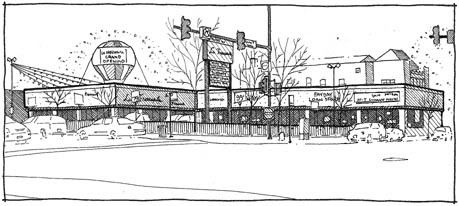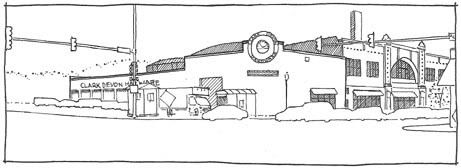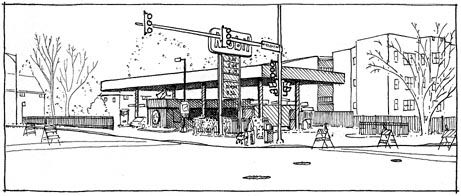 OK, I've ventured out of Rogers Park for this drawing. This is kind of on the edge of Bronzeville on the south side. Had it been a bit warmer it would've been a great area to explore better. There's a historic district (Oakland) near the east terminus of 43rd, and I was intent on making a site visit without a car. One advantage is that you can meander a bit on the way back to the El. This sign is still in front of a furniture store, although probably not the original tenant that put it up.
OK, I've ventured out of Rogers Park for this drawing. This is kind of on the edge of Bronzeville on the south side. Had it been a bit warmer it would've been a great area to explore better. There's a historic district (Oakland) near the east terminus of 43rd, and I was intent on making a site visit without a car. One advantage is that you can meander a bit on the way back to the El. This sign is still in front of a furniture store, although probably not the original tenant that put it up. Saturday, January 31, 2009
43rd and Cottage Grove
 OK, I've ventured out of Rogers Park for this drawing. This is kind of on the edge of Bronzeville on the south side. Had it been a bit warmer it would've been a great area to explore better. There's a historic district (Oakland) near the east terminus of 43rd, and I was intent on making a site visit without a car. One advantage is that you can meander a bit on the way back to the El. This sign is still in front of a furniture store, although probably not the original tenant that put it up.
OK, I've ventured out of Rogers Park for this drawing. This is kind of on the edge of Bronzeville on the south side. Had it been a bit warmer it would've been a great area to explore better. There's a historic district (Oakland) near the east terminus of 43rd, and I was intent on making a site visit without a car. One advantage is that you can meander a bit on the way back to the El. This sign is still in front of a furniture store, although probably not the original tenant that put it up.
Labels:
Cottage Grove,
marker,
neon,
pen and ink,
signage
Wednesday, January 28, 2009
Clark and Lunt, northeast corner- 1890s through 2008
Our corner is on the far right. At this point (1890s) it was a post office.
Who doesn't love an old timey bus? Here's the first Philip's Bank. c. 1915?
Here's the upgrade of Philip's Bank in the 1920s.
And here's the triumphant replacement. I believe it was built in 1997, two years after I moved to Chicago.
Who doesn't love an old timey bus? Here's the first Philip's Bank. c. 1915?
Here's the upgrade of Philip's Bank in the 1920s.
And here's the triumphant replacement. I believe it was built in 1997, two years after I moved to Chicago.
Labels:
black and white,
Clark,
corner,
pen and ink,
Rogers Park
Monday, January 26, 2009
Clark and Devon, northeast corner- 1910 and 2009
Apartments and Retail, c.1910
Devon-Clark Hardware, 2009
I'm fairly certain that this demolished apartment building explains the strangely shaped parking lot west of Devon-Clark Hardware. Still trying to figure out the map chronology, which is somewhat vague for this area.
Labels:
black and white,
Clark,
corner,
pen and ink,
Rogers Park
Saturday, January 24, 2009
Clark and Touhy, northeast corner
7201 N. Clark
Built: 1955 (this is probably a rebuild)
This gas station was out of business when I started this project. But here it is, triumphant in its reopening.
The past few weeks we've lived through some of the coldest Chicago weather I've ever experienced. We're all getting over various stages of colds, but otherwise fine. Last weekend we went to Winterfest at Warren Park, where Felix bounced on an inflatable trampoline for an hour, had a spider painted on his hand, and took home a tiger balloon animal. We attended the grand opening of a new firehouse on Clark (Mayor Daley gave a speech, but at least there were donuts). And we've pioneered the sport of toddler sledding as a practical form of neighborhood transport.
Built: 1955 (this is probably a rebuild)
This gas station was out of business when I started this project. But here it is, triumphant in its reopening.
The past few weeks we've lived through some of the coldest Chicago weather I've ever experienced. We're all getting over various stages of colds, but otherwise fine. Last weekend we went to Winterfest at Warren Park, where Felix bounced on an inflatable trampoline for an hour, had a spider painted on his hand, and took home a tiger balloon animal. We attended the grand opening of a new firehouse on Clark (Mayor Daley gave a speech, but at least there were donuts). And we've pioneered the sport of toddler sledding as a practical form of neighborhood transport.
Labels:
black and white,
Clark,
corner,
pen and ink,
Rogers Park
Subscribe to:
Posts (Atom)







